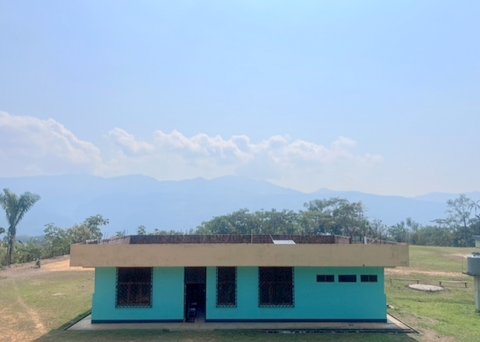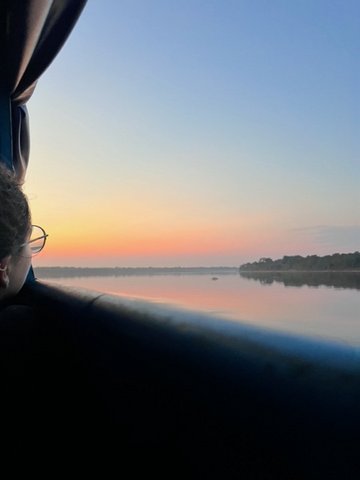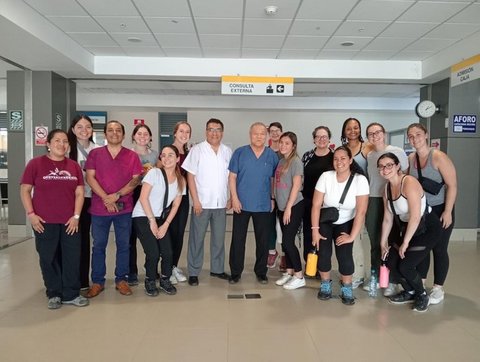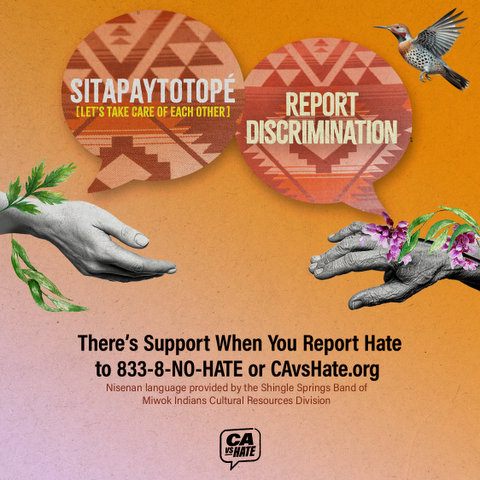
14 Nov Backpacking in Peru Taught Me a Lesson on Health and Humility

This is the only health clinic in the Indigenous community of Chiricyacu, Peru.
Commentary and photos by Naja Ji Jaga
I backpacked through Peru for two weeks in August, and this atypical trip taught me significant lessons I would not have otherwise learned. As a student at Boston University with aspirations of becoming a physician assistant, I was excited to embark on this service-learning trip to explore the diversity of the healthcare landscapes of Peru and compare it with the ones I grew up with in the United States. During my time there, I gained valuable insights into the healthcare, culture and resourcefulness of the people, unlike what I’ve ever been familiar with.
My journey started in the coastline capital of Peru, Lima, where the bluest water had dozens of people rowing in handcrafted boats or surfing. Next, I took a domestic flight to Tarapoto and rode in the back of a pickup truck to the native town of Chiricyacu. Then, I took an 18-hour boat ride to Nauta. The boat got stuck in the Amazon River for two hours, but that let everyone marvel at the pink dolphins that would jump out of the waters. From there, I spent three days in the Amazon jungle, learning traditional medicine and hiking in the jungle, where a variety of monkeys were found climbing the tall trees. Lastly, I rode in a van to Iquitos, a city that reminded me a lot of my hometown of Richmond. All the while, when viewing these breathtaking sites, I explored and gained a deeper understanding of Peru’s healthcare system.
- During an 18-hour ride on the Amazon from Chiricyaku to Nauta in Peru, the boat got stuck for two hours.
Our group stayed with Casilda, an Amazonian healer who practiced traditional medicine that was passed down generationally to her. During the first night of the 3-day stay, we hiked through the jungle to the nearby town of Puerto Miguel, the halfway point of our hike. The small neighborhood had a school and a few stores, the second floors of which contained homes for different Peruvian families, and stray dogs roamed freely. One of which, unfortunately, became the source of a valuable lesson for us all.
One dog bit the back of Casilda’s leg, leaving a deep wound. Using the first-aid kit carried by our guide, we helped stop the bleeding and cleaned and dressed the wound. However, there was still the risk of infection and rabies, so now we had to worry about how she would get to the nearest hospital.
Casilda didn’t want to go immediately, but eventually, the pain became too excruciating to ignore. She left at 4 a.m. to make it to the nearest hospital — two hours away by boat. After receiving rabies vaccinations, treatment and medications from a doctor, she didn’t return until the afternoon after another 2-hour boat ride back home. Despite the wild experience, Casilda returned and taught us about herbal medicine, traditional medicines and her healing techniques. This testament to resilience was a common theme in Peru, which I found inspiring.
When I visited the biggest hospital in Tarapoto, I met dedicated physicians, nurses and technicians who welcomed me with open arms. Multiple healthcare workers, and even the hospital owners, took time from their busy days to give a tour. At the same time, the healthcare workers shared their very real frustrations over their need for more supplies. They explained how healthcare resources are not readily available in rural areas, and services like speech and physical therapy are only available at their hospital, five hours away by car. This inaccessibility prevents many patients from returning for treatment.
But that never deterred these providers. They are highly motivated to find new ways to help people. In fact, during the COVID-19 pandemic, many of Peru’s healthcare workers sought further education to become a better resource for their patients.
- Hospital directors and others at the medical center in Tarapoto, Peru.
In contrast, a Level 1 hospital in the rural town of Chiricyacu had only two nurses, a small emergency room, a maternity ward, and a pharmacy with a lot of medications. I was surprised by the vast array of birth control options provided through U.S.-funded programs, which have influenced family planning and contributed to lower fertility rates in the region. A local woman said she was born into a family with nine siblings but only has four children herself. This is out of the norm generationally, but it is more common nowadays for families to conceive fewer children.
The hospital also prioritized maternal and child health, with a dedicated room focused on mothers during and after pregnancy, emphasizing maternal health even in resource-limited settings.
Black Infant Health Helps Black Moms ‘Give Birth the Way She Wants’
Another especially memorable part of my journey was meeting members of Red Trans, a support group of transgender women who spoke about the healthcare discrimination they face as patients. They face high levels of violence because hospitals are unequipped, medically and culturally, to treat these women. Due to the stigmas trans women face in Peru, transgender women have disproportionately high cases of HIV. While a handful of physicians have used incentives like hormones for women to continue receiving HIV treatment, the lack of acceptance in hospital settings has kept these women at a higher health and death risk. This is an area where both Peru and the U.S. are similarly struggling. Still, it has shown me the importance of advocating for cultural competency in healthcare settings to which I will contribute.
While reflecting on this trip, I realize how fortunate I am to have accessible healthcare in times of need. The resilience of people like Casilda, the dedication of the Peruvian healthcare worker, and the needs of vulnerable communities like Red Trans have reminded me of the complexity and diversity within healthcare. This experience has taught me to be highly grateful for education and resources in the U.S. and to recognize wisdom. There were many similarities and differences that the U.S. could learn a lot from, as well as the resourcefulness that traditional and community-based care can bring. As a future healthcare worker, I want to blend all the excellent care methods and lessons I learned from Peru and the U.S. health providers and apply them to every setting I find myself in.








No Comments